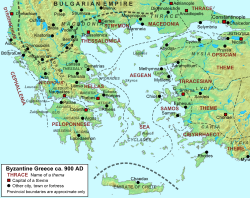Thessalonica (theme)
| Theme of Thessalonica Θεσσαλονίκη, θέμα Θεσσαλονίκης |
|||||
| Theme of the Byzantine Empire | |||||
|
|||||
| Map of Byzantine Greece ca. 900 AD, with the themes and major settlements. | |||||
| Capital | Thessalonica | ||||
| Historical era | Middle Ages | ||||
| • | Established | 809 | |||
| • | Fourth Crusade | 1204 | |||
| • | Recovery by Nicaean Empire | 1242 | |||
| • | Captured by Ottomans | 1392 | |||
| Today part of |
|
||||
The Theme of Thessalonica (Greek: θέμα Θεσσαλονίκης) was a military-civilian province (thema or theme) of the Byzantine Empire located in the southern Balkans, comprising varying parts of Central and Western Macedonia and centred on Thessalonica, the Empire's second-most important city.
In Late Antiquity, Thessalonica was the capital of the Roman province of Macedonia and of the Diocese of Macedonia, and the seat of the praetorian prefect of Illyricum. With the loss of most of the Balkan hinterland to the Slavic invasions in the 7th century, however, the authority of the prefect (in Greek eparchos, "eparch") was largely confined to the city and its immediate surroundings. The eparch continued to govern Thessalonica until the early 9th century, when he was replaced by a strategos at the head of the new theme of Thessalonica.
The strategos of Thessalonica is attested for the first time in 836, but a letter of Emperor Michael II (r. 820–829) to the Frankish king Louis the Pious (r. 814–840) may indicate the theme's existence already in 824. The historian Warren Treadgold dates the theme's creation to c. 809, during the anti-Slavic campaigns of Emperor Nikephoros I (r. 802–811) which extended Byzantine rule to the city's hinterland. Treadgold further conjectures that its troops in the 9th century numbered about 2,000 men. To the east, the theme extended to the river Strymon and the theme of the same name. To the south, it bounded the theme of Hellas, somewhere in northern Thessaly. Its western and northern bounds were undetermined, fluctuating with the tide of war between the Byzantines, the local Slavic tribes, and eventually the Bulgarians.
...
Wikipedia

